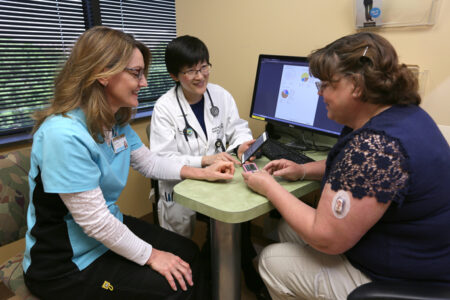For patients with type 2 diabetes treated with basal or long-acting insulin, the use of continuous glucose monitors (CGMs) can result in significantly lower hemoglobin A1C (a blood test that reflects average blood glucose levels over three months), and better management of the disease, according to a study recently published in JAMA.
Vanderbilt University Medical Center was one of 15 recruitment centers in the United States for the randomized clinical trial in which researchers compared the effectiveness of traditional finger-stick monitoring to the use of continuous glucose monitors. The eight-month study followed 175 participants with type 2 diabetes on basal insulin who received their diabetes care from a primary care clinician.

Shichun Bao, MD, PhD, associate professor of Medicine, led the effort at VUMC. Bao also leads a Diabetes Technology Program at the Vanderbilt Eskind Diabetes Clinic, where she guides patients on how to better use devices such as CGMs and insulin pumps to improve diabetes management.
“I’m not surprised by the results,” Bao said. “Everybody with diabetes would benefit from using these technologies. And one big strength of this study is the involvement of the participants’ primary doctors. We didn’t manage the participants’ diabetes; we collected the data. We talked on the phone with the patient every two months and sent a report to their primary care providers to share their patient’s CGM data. The patient saw it, and the primary care provider saw it, and that triggered improvement.”
CGMs have previously been shown to greatly improve glucose control for patients with type 1 diabetes and are becoming the standard of care for these patients.
CGMs have also been shown to be beneficial for patients with type 2 diabetes managed with multiple daily insulin injections, but their use in type 2 diabetes treated with basal insulin (longer-acting insulin) without prandial (fast-acting) insulin, the focus of this study, has not been well researched.
At the beginning of the study, participants’ average A1C level was around 9.1%. A1C levels above 7% are associated with an increased risk of diabetes complications.
One hundred sixteen, or two-thirds, of the participants were randomized to use CGMs and 59 participants used traditional finger-stick glucose monitoring. CGMs measure interstitial fluid glucose levels continuously through a sensor placed on the skin, send glucose readings to personal smartphone/smartwatch or a receiver every five minutes via Bluetooth, and also alert patients when glucose is too high or too low. Patients can also share CGM data with their loved ones, caregiver and health care providers so they can assist with diabetes management.
By study’s end, those using CGMs had reduced A1C by 1.1% on average, compared to a 0.6% reduction for those using traditional finger stick glucose monitors. Another promising study outcome is that participants wearing CGMs spent on average 3.8 more hours per day within the target glucose range.
One of the study’s strengths is that it included a racially and socioeconomically diverse participant population, with most participants being non-white, with less than a college degree and without private insurance.
Since the first CGM system was approved by the Food and Drug Administration (FDA) in 1999, the devices have become smaller, more affordable, more accurate and more user-friendly. Bao is hopeful that this study will drive CGM becoming available to a wider patient population and that primary care providers will be more comfortable prescribing CGMs to better care for their patients with diabetes.
There are recent relaxations of the requirements that must be met for patients to receive coverage of CGMs, Bao said. For example, beginning July 18, the Centers for Medicare & Medicaid Services (CMS) requirement of proof of blood testing four times or more daily before qualifying for a CGM is ending. CMS is also broadening CGM coverage for those who use inhaled insulin by permitting multiple daily “administrations” of any insulin. Previously, it was restricted to insulin “injections.”
Cost can still be a barrier to CGM use — some can be around $300-400 a month for those without insurance or a $20-$80 monthly copay for individuals with insurance. There are also saving discounts offered by device manufacturers and other programs. Medicare Part B covers CGM fully (no cost to patients) although strict criteria must first be met.
“CGM is really beneficial for everybody, not just those with type 1 diabetes, but also those with type 2 or other diabetes who are not on multiple daily insulin injections or insulin pumps. My hope is that the data will lead to more people being prescribed this technology to help keep their diabetes under better control, and that there are more advocates for CGM, from the patients themselves to the providers,” Bao said.
Study funding and study devices were provided by Dexcom Inc., a company that develops, manufactures and distributes continuous glucose monitoring systems for diabetes management. Dexcom representatives were not involved in data collection, management or analysis.












